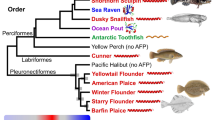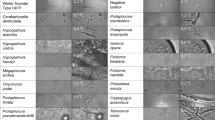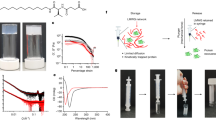Abstract
MUCH information has been gathered in recent years on the so-called ‘antifreeze’ proteins which lower the freezing point of the serum of certain marine fishes living in sub-zero water temperatures1–4. The proteins from the Antarctic fish Trematomus borchgrevinki are glycoproteins with a repeating alanyl-alanyl-threonyl tripeptide sequence, the threonyl residue being linked to a disaccharide1,2. In contrast, the antifreeze protein from the winter flounder Pseudopleuronectus americanus in the North American Atlantic coastal region is made up of eight ammo acids with no apparent repeating sequence of the residues and no sugar moiety (ref. 4 and unpublished work of C. L. Hew, C. C. Yip & G. Fletcher). The antifreeze activity of these proteins is not compatible with the known colligative properties of solutes in solution and the mechanism of their action is not yet fully understood. But a common feature of both types of the antifreeze proteins is the preponderance of alanine which accounts for over 60% of the total amino residues. This fact, together with the absence of the carbohydrate in the protein from the winter flounder, prompted us to attempt the synthesis of polypeptide analogues having comparable proportions of alanine in them along with suitable other amino acids. As a first step, we made use of the lack of any obvious periodicity in the distribution of the alanyl residues in the flounder's protein and attempted the synthesis of a random copolypeptide containing about 65 mol % of alanine and 35 mol % of aspartic acid. The choice of aspartic acid was made on the basis of its being the next major amino acid in the flounder's protein3,4 and on the expectation that its polar character will help the water-solubility of the alanine-rich copolypeptide, as in other studies on alanine-containing random copolymers. In addition, Duman and DeVries4 have earlier indicated the involvement of carboxyl groups on the antifreeze activity by chemical modification studies. We report here the synthesis of this polypeptide and show that it possesses antifreeze activity.
This is a preview of subscription content, access via your institution
Access options
Subscribe to this journal
Receive 51 print issues and online access
$199.00 per year
only $3.90 per issue
Buy this article
- Purchase on SpringerLink
- Instant access to full article PDF
Prices may be subject to local taxes which are calculated during checkout
Similar content being viewed by others
References
Feeney, R. E. Am. Scient. 62, 712–719 (1974).
DeVries, A. L. in Biochemical and Biophysical Perspectives in Marine Biology 1, 290–327 (Academic, New York, 1974).
Hew, C. L. & Yip, C. C. Biochem. biophys. Res. Commun. 71, 845–850 (1976).
Duman, J. G. & DeVries, A. L. Nature 247, 237–238 (1974); Comp. Biochem. Physiol. 54B, 375–380 (1976).
Platzer, K. E. B., Ananthanarayanan, V. S., Andreatta, R. H. & Scheraga, H. A. Macromolecules 5, 177–197 (1972).
Idelson, M. & Blout, E. R. J. Am. Chem. Soc. 80, 4631–4634 (1958).
Matsura, S., Niu, C.-H. & Cohen, J. S. Chem. Soc. Chem. Commun. 451–452 (1976).
Ananthanarayanan, V. S. & Hew, C. L. Biochem. biophys. Res. Commun. 74 685–689 (1977).
Author information
Authors and Affiliations
Rights and permissions
About this article
Cite this article
ANANTHANARAYANAN, V., HEW, C. A synthetic polypeptide with antifreeze activity. Nature 268, 560–561 (1977). https://doi.org/10.1038/268560a0
Received:
Accepted:
Issue date:
DOI: https://doi.org/10.1038/268560a0
This article is cited by
-
Structure, biosynthesis and functions of glycoprotein glycans
Experientia (1982)



